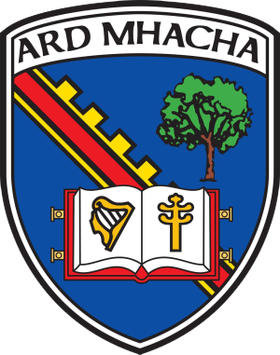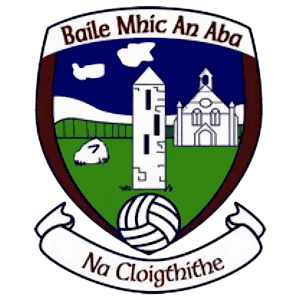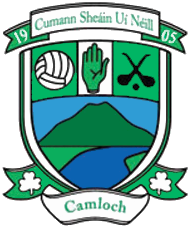
Armagh is the county town of County Armagh and a city in Northern Ireland, as well as a civil parish. It is the ecclesiastical capital of Ireland – the seat of the Archbishops of Armagh, the Primates of All Ireland for both the Roman Catholic Church and the Church of Ireland. In ancient times, nearby Navan Fort was a pagan ceremonial site and one of the great royal capitals of Gaelic Ireland. Today, Armagh is home to two cathedrals and the Armagh Observatory, and is known for its Georgian architecture.

Cullyhanna is a small village and townland in County Armagh, Northern Ireland. The village extends further over the townlands of Tullynavall and Freeduff. It had a population of 306 in the 2001 Census. It is within the Newry and Mourne District Council area.

The Armagh County Board or Armagh GAA is one of the 32 county boards of the Gaelic Athletic Association (GAA) in Ireland, and is responsible for the administration of Gaelic games in County Armagh, Northern Ireland.

Belleeks is a small village and townland in south County Armagh, Northern Ireland. In the 2011 Census it had a reported population of 375. It lies within the Newry, Mourne and Down District Council area and the historic barony of Upper Fews.
Michael McVerry, was a Provisional Irish Republican Army volunteer and Officer Commanding of the First Battalion of the Provisional IRA South Armagh Brigade. He was killed in Keady in 1973.

Derrynoose is a village and civil parish in south County Armagh, Northern Ireland, 4.5 km south-west of Keady.
The South Armagh Republican Action Force shortened simply to the Republican Action Force for a small number of attacks in Belfast was an Irish republican paramilitary group that was active from September 1975 to April 1977 during the Troubles in Northern Ireland. Its area of activity was mainly the southern part of County Armagh. According to writers such as Ed Moloney and Richard English, it was a cover name used by some members of the Provisional IRA South Armagh Brigade. The journalist Jack Holland, alleged that members of the Irish National Liberation Army (INLA) were also involved in the group. During the same time that the South Armagh Republican Action Force was active the INLA carried out at least one sectarian attack that killed Protestant civilians using the covername "Armagh People's Republican Army". According to Malcolm Sutton's database at CAIN, the South Armagh Republican Action Force was responsible for 24 deaths during the conflict, all of whom were classified as civilians.

Granemore is a townland of 785 acres in County Armagh, Northern Ireland, about seven miles from Armagh and three miles from Keady. It is situated in the civil parish of Keady and historic barony of Armagh.

Operation Conservation was an attempt by the British Army to ambush a large Provisional Irish Republican Army (IRA) unit along the Dorsey Enclosure, between Cullyhanna and Silverbridge, in south County Armagh. The action took place on 6 May 1990 but was thwarted by the South Armagh Brigade of the IRA.
All Saints Gaelic Athletic Club is the only Gaelic Athletic Association club in the town of Ballymena, County Antrim. The club is a member of the South-West Antrim division of Antrim GAA, and competes in Gaelic football, hurling, Ladies Gaelic football and camogie.
Féile na nGael is an annual tournament comprising the sports of hurling, camogie and handball organised by the Gaelic Athletic Association. Its stated aim is to bond communities, forge friendships, provide educational opportunities and unearth new leaders.
The All-Ireland Club Camogie Championship is a competition for club teams in the Irish women’s field sport of camogie. It is contested by the senior club champions of the leading counties and organised by An Cumann Camógaíochta.

Ballymacnab Round Towers Gaelic Athletic Club is a Gaelic Athletic Association club within Armagh GAA. It is based in the townland and village of Ballymacnab in County Armagh, Northern Ireland, in the parish of Cill Chluana, four miles south of the city of Armagh.

St Michael's Gaelic Athletic Club, Newtownhamilton is a GAA club in Armagh. It's playing fields fall within the townland of Tullyvallan, including the village of Newtownhamilton, in south County Armagh. St Michael's plays Gaelic football and is currently in the Armagh Junior Football Championship.

St Patrick's Gaelic Football Club is a Gaelic Athletic Association club in southern County Armagh, Northern Ireland. It is part of the Armagh GAA, and is based in the townland and village of Cullyhanna.

Shane O'Neill's Gaelic Athletic Club is a GAA club from Camlough, County Armagh. It is part of Armagh GAA and its grounds are known as Páirc Sheáin Uí Néill.

The Armagh disturbances was a period of intense sectarian fighting in the 1780s and 1790s between the Ulster Protestant Peep o' Day Boys and the Roman Catholic Defenders, in County Armagh, Kingdom of Ireland, culminating in the Battle of the Diamond in 1795.















